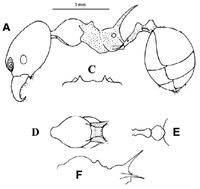Pheidole mutisi
| Pheidole mutisi | |
|---|---|

| |
| Scientific classification | |
| Kingdom: | Animalia |
| Phylum: | Arthropoda |
| Class: | Insecta |
| Order: | Hymenoptera |
| Family: | Formicidae |
| Subfamily: | Myrmicinae |
| Tribe: | Attini |
| Genus: | Pheidole |
| Species: | P. mutisi |
| Binomial name | |
| Pheidole mutisi Fernández & Wilson, 2008 | |
The type material was collected from the litter of montane humid forest.
Identification
Fernández & Wilson (2008) - The very long propodeal spines, body smooth and shining lacking pilosity (major) distinguishes this new species from any other New World Pheidole.
Distribution
Latitudinal Distribution Pattern
Latitudinal Range: 1.3° to 1.3°.
| North Temperate |
North Subtropical |
Tropical | South Subtropical |
South Temperate |
- Source: AntMaps
Distribution based on Regional Taxon Lists
Neotropical Region: Colombia (type locality).
Distribution based on AntMaps
Distribution based on AntWeb specimens
Check data from AntWeb
Countries Occupied
| Number of countries occupied by this species based on AntWiki Regional Taxon Lists. In general, fewer countries occupied indicates a narrower range, while more countries indicates a more widespread species. |

|
Estimated Abundance
| Relative abundance based on number of AntMaps records per species (this species within the purple bar). Fewer records (to the left) indicates a less abundant/encountered species while more records (to the right) indicates more abundant/encountered species. |

|
Biology
Castes
Worker
Minor
 
| |
| . | |
Nomenclature
The following information is derived from Barry Bolton's Online Catalogue of the Ants of the World.
- mutisi. Pheidole mutisi Fernández & Wilson, 2008: 207, figs. 1, 2 (s.w.) COLOMBIA.
Unless otherwise noted the text for the remainder of this section is reported from the publication that includes the original description.
Description
Worker
Holotype major (paratype minor) HL 1.38 (0.80) HLA 0.35 (0.30) HW 1.20 (0.61) SL 0.98 (1.07) EL 0.19 (0.14) ML 1.35 (1.08) PSL 0.50 (0.50) PMG 0.08 (0.06) SPL 0.08 (0.04) PTW 0.23 (0.11) PPW 0.33 (0.2) IHT 0.44 OHT (0.50 aprox.) CI 87 (77) SI 71 (134) PSLI 36 (63) PMGI 5.4 (7.1) SPLI 5.8 (5.4) PPI 145 (175) HTI 88 (aprox.).
A medium size member of the Pheidole diligens group, distinguished by the following traits.
Major. Light brown, medium sized, head slightly longer than broad, sides slightly convex, vertex deeply convex in the middle, in lateral view, mesonotum narrowly produced, propodeal spines very long, surpassing petiolar length; head, mandibles, promesonotum, coxae, dorsum of petiole and postpetiole and gaster smooth and shining, mesopleuron and propodeum reticulate, sides of petiole and postpetiole finely reticulate; except for appendages, body completely lacking pilosity.
Minor. Light brown, occiput narrowed with short nuchal, propodeal spines in side view noticeably longer than petiole, and from above divergent; dorsum of head, petiole and gaster with long, erect hairs (largest about 0.26 mm), rest of body (except appendages) without pilosity.
Color. Major and minor: Body light brown, in major mandibles and genae dark brown.
Type Material
(Major). Colombia, Nariño. Altaquer. Barbacoas. El Barro. Ñambí Natural Reserve, 1º18’N 78º05’W, 1200 m., 1-March-2006, S. Cabrera leg. No. 32 (Deposited in Insect Collection, Instituto de Ciencias Naturales); Paratypes (One major, two minors), same data (Deposited in ICN, Museum of Comparative Zoology).
Etymology
Named after José Celestino Mutis, the distinguished XVIII naturalist, named “The Wiseman”, a Neogranadinian who realized the first study of habits in tropical ants in the Americas.
